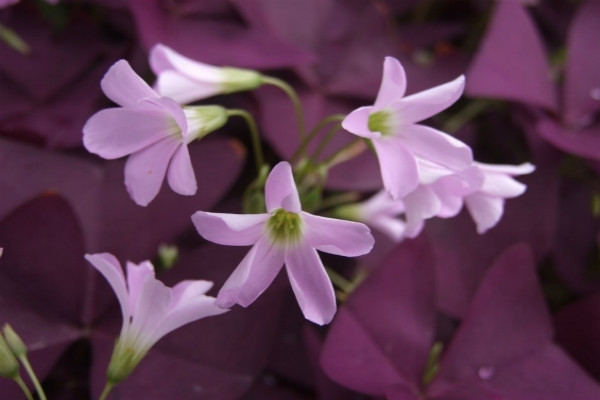Disease symptoms and treatment of mole cricket in North China of Oxalis purpurea
1. Morphological characteristics
Mole cricket in North China belongs to Orthoptera (Gryllotalpidea), also known as Orthoptera. The adult is 36-55mm long and yellowish brown. The wing is short, the forefoot is flat and strong, there is a thorn on the inner edge of the tibial segment of the hindfoot, and there are two tail whiskers at the end of the body. The egg is oval, milky white at birth, shiny, and then yellowish brown.
2. Occurrence regularity
Mole cricket in North China has one generation in about 3 years. Adults and nymphs of all ages above 8 years old overwintered in the soil, sometimes as deep as 150cm. Between April and May of the following year, they began to take food. Mole cricket in North China has a large size, poor flying ability, eating sweet and fragrant rotten organic matter, Sima dung and moist soil. Mole cricket in North China sleeps during the day and goes out at night, and the peak of active feeding is from 21 to 22:00. There is also a certain relationship between soil texture and population density. In saline-alkali soil, the density of insect population is the highest, followed by loam, and clay is the least.
3. Hazard characteristics
The feeding habits of mole cricket in North China are very miscellaneous, and the adults and nymphs are active in the soil, feeding on the bulbs and young leaves of Oxalis purpurea or biting off the seedlings, and the roots of the damaged plants are tangled. As the mole cricket in North China passes through the surface and forms many tunnels, the seedlings are separated from the soil, and the seedlings often dry up and die because of the loss of water.
4. Prevention and cure measures
① agricultural prevention and control:
Mole cricket in North China is not resistant to flooding, irrigation will force adults to emerge from the soil, easy to catch and kill. Avoid using immature organic manure. Find the nest of mole cricket in North China and destroy both the egg and the female.
Physical Prevention and Control of ②:
Making use of the phototaxis of mole cricket in North China, a black light was set up to trap and kill adults during its Eclosion.
Chemical control of ③:
First stir-fry blighted grain, wheat bran, bean cake, cottonseed cake or corn crushed 5kg, then use 90% trichlorfon 30 times liquid 0.15kg, add the right amount of water, mix the tide for a degree, the effect is better in the stifling evening without wind. Bait can also be mixed with 40% dimethoate EC 10 times or other pesticides.
How to explode the purple leaf grass, learn six skills: both beautiful and vigorous
Among the plants of the genus Oxalis, Elaeagnus angustifolia, native to South America, is famous for its colorful flowers. It is not only easy to raise but also grows very fast, but it still takes some skills to make it beautiful and grow rapidly. and how does the purple leaf grass burst the pot? Next, the editor will teach you six skills.
How to explode the purple leaf grass in the basin
1. The light should be moderate

When planting, it is best to plant it in a semi-light environment, such as under the eaves, indoor windows, balconies and other places, do not let the purple leaf grass be exposed to direct sunlight, and avoid the environment where the light is too weak, otherwise the leaf color will be dim and the plant shape may grow steeply.
2. Water should not be too much.
In the cultivation method of purple leaf sorrel, it is best to use spray irrigation when watering, the method is to spray water to the plant with a spray pot, in addition to being able to wash the leaves, the excess water will be naturally left in the soil to be absorbed by the roots. however, we need to pay attention not to watering too many times, wait until the soil is slightly dry before watering, avoid stagnant water.
3. Pruning should be timely.
Although many flower friends watering is very reasonable, but they have found that it grows very fast, so how does the purple leaf grass burst the pot? It still needs to be trimmed at this time. Some branches and leaves are staggered together because of their rapid growth, which is not only not conducive to light transmission, but also affect the germination of new buds, so we should pay attention to observation during daily maintenance and find that a large number of branches and leaves should be thinned when they are dense.
4. Change the basin soil regularly
The soil used for raising Oxalis should be changed every 1 or 2 years to avoid dry knot, air permeability and poor drainage, and reduce the possibility of insect sources latent in the soil. And the replacement of the soil is best to do disinfection treatment, to ensure a good soil environment is conducive to its explosion.
5. The temperature should be suitable.
In summer, try to keep the ambient temperature below 30 degrees. If the outdoor temperature is higher, you can move to a cool place. In winter, we should ensure that the temperature is above 5 degrees, so that it can go dormant smoothly but will not be frostbitten. Only by getting proper dormancy can it grow more prosperous in the second year.
6. Prevention of diseases and insect pests
The common pests of Elaeagnus angustifolia are rock mites, tobacco thrips, mole cricket in North China, wild slugs and so on, while its common diseases are leaf spot, root rot and so on, which do great harm to Oxalis. However, we can reduce the occurrence of diseases and insect pests by strengthening conservation management, and the way is to make the environment suitable.
- Prev

Symptoms and Treatment of Myzus persicae Disease in Oxalis purpurea
1. Morphological characteristics of Myzus persicae belongs to Homoptera Aphidoidea, also known as red aphid. Myzus persicae is small, female aphid head, chest black, antenna 6, abdomen green, brown, yellow green or reddish brown, back has light black stripes
- Next

Disease symptoms and treatment of Artemisia mandshurica
1. Morphological characteristics of the same type of snails belong to Stylommatophora (Bradybaenidae), also known as water buffalo. Adult shell volute flat spherical, solid and thick, the shell surface is yellowish brown or reddish brown, the shell mouth is horseshoe-shaped. Ovoid, milky white
Related
- Fuxing push coffee new agricultural production and marketing class: lack of small-scale processing plants
- Jujube rice field leisure farm deep ploughing Yilan for five years to create a space for organic food and play
- Nongyu Farm-A trial of organic papaya for brave women with advanced technology
- Four points for attention in the prevention and control of diseases and insect pests of edible fungi
- How to add nutrient solution to Edible Fungi
- Is there any good way to control edible fungus mites?
- Open Inoculation Technology of Edible Fungi
- Is there any clever way to use fertilizer for edible fungus in winter?
- What agents are used to kill the pathogens of edible fungi in the mushroom shed?
- Rapid drying of Edible Fungi

